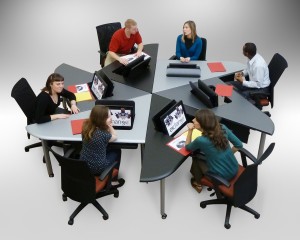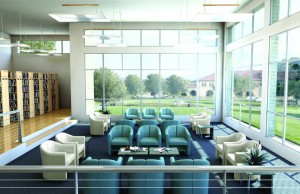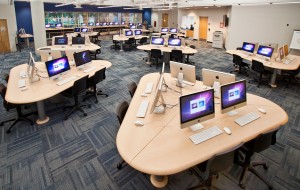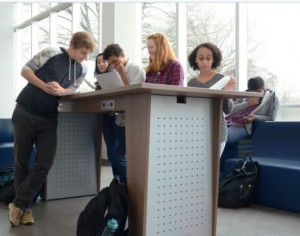Designing and Optimizing Your 21st Century Higher Ed Learning Space For Millenials
Administrators, Department Heads and Facilities Managers: Section 1: Setting Up Ideal Learning Conditions for Millennial College Students
Professors, Lecturers, Instructors, and Teachers: Section 2: Using Your Learning Space to Be a Better 21st Century College Teacher

The best practices in higher education spaces have evolved. University education isn’t what it used to be. Enormous lecture halls with hard seating and tablet-arm chairs, professors speaking with a monotone from printed notes, and standard library tables with old-fashioned seating are out. They have been replaced by collaboration, project-based learning and modern technology. If you want to stay in the game of higher education, you must update your space and learn how to utilize 21st century learning tools.
Setting Up Ideal Learning Conditions for Millennial College Students
If you want to keep your institution of higher education relevant for college-bound millennials, here are some important design tips to keep in mind.
1. Offer plenty of electrical outlets and recharging stations wherever possible.
Whether they are in the library, cafeteria or lecture hall, college students expect to be plugged into multiple devices at all times. That means you need charging stations in study spaces and break areas, as well as plenty of accessible USB power outlets in all classrooms. Almost all of today’s students are taking notes on laptops or tablets, which means that they need to have consistent access to reliable power sources.
2. Ensure that you have a reliable wireless network throughout the campus.
Nothing is more frustrating to a college student who has to hand in an assignment by midnight than realizing that the internet is down at 11:30 PM. Students and professors expect to use the internet to complete assignments, practice problems and simulations, and access information about grades and lecture notes. An unreliable wireless network or some weak spots on the campus can lead to intense frustration for everyone in your higher education community.
3. Keep your university library furniture up to date.

The hard lines of classic boxy wooden library tables and chairs simply don’t appeal to today’s students. Your university library needs some flexible soft seating and modern study pods. Classic carrels are a thing of the past. Contemporary study pods with cushy seating, vibrant colors and built-in hookups are exactly what your students need, no matter what discipline they are studying. As the importance of collaboration only increases for potential employers, college students are consistently expected to work in groups. With a media center that accommodates groups of various sizes in comfortable collaborative areas, you can ensure that the learning spaces fit the teaching styles and expectations of today’s great courses.
4. Create science labs which support interdisciplinary and project-based learning.
While some institutions of higher education are still categorizing courses according to antiquated rigid categories, many colleges and universities have adopted a more interdisciplinary approach. Most of the world is not separated into defined subject areas, so a more interdisciplinary approach is reflective of the world today, especially in STEM fields. This means that well-equipped, up-to-date science labs are essential for supporting the study of STEM fields. These spaces should have plenty of flexible work-spaces, with the proper safety precautions taken, as well as a variety of tools and materials.
5. Provide engaging learning spaces.
Color and style set the mood for the classroom, but creating an engaging space goes well beyond stylistic choices. Rethinking the higher ed classroom means paying equal attention to design and function. College students expect lectures to be engaging and interactive, which means the space needs to support these ideals. The classroom needs to be flexible to accommodate comfortable work in groups of different sizes. There needs to be a great multimedia system, or ideally even a smart-board, so teachers can create interactive presentations which are easily visible to the whole class and engaging to our multitasking millennials.
Using Your Learning Spaces to Be a Better 21st Century College Teacher
Having a space that is set up to support 21st century learning for college students is only the first step in keeping higher education relevant and enticing to millennials. Once the space is set up, professors need to make sure they are using it to its full potential. There is no point in having a smart-board or a space that is designed for project-based learning, if you don’t know how to take advantage of it. Here are some guidelines for utilizing your learning spaces to be a better 21st century college teacher.
1. Facilitate Collaborative Problem-Solving
Students aren’t just going to wake up one day and figure out how to collaborate, they need someone to push them and encourage them to hone the required skills. Whether in the library or the lab, professors should be taking advantage of flexible furniture to help students create the physical space which is most conducive to successful group work. In addition to setting up the space correctly, teachers and professors should make collaboration a mandatory component of their courses. For example, you can assign students to study groups which are responsible for figuring out a weekly problem or challenge either during or outside of class. You may even want to consider some reflection exercises afterward, so students can think about what does and doesn’t work for them in small-group learning.
2. Make Yourself Accessible to Students
Scanning the sea of faces throughout a lecture and waiting for students to drop-in during office hours will not build the kinds of connections millennial college students expect. In the age of instant access to almost everything, professors are expected to keep up. That means answering E-mails in a timely, and more informal fashion, even when they might seem trivial. Students expect everyone to be connected on a very consistent basis, so checking your E-mail once a day will simply not suffice anymore. Professors need to make a habit of answering students within a few hours of when their questions are sent (though they will likely be expecting a response already after just a few minutes!).
3. Share Digital Copies of Everything
No one buys physical textbooks anymore. If you are compiling a course reader, the individual components should be accessible in easy-to-read formats which allow for digital note taking as well. These documents should be uploaded to a course website where students can easily follow which materials they need at all times. Alternatively, find an updated online textbook which includes problems and questions which can be solved and checked digitally on the spot.
4. Encourage Digital Participation
Some college students simply refuse to speak up in class, and forcing them to do so for a participation requirement will not foster good will. By creating an online class forum where students are required to post, you can check-in on how they are processing information and ensure participation in a way that is comfortable for everyone. This is also a great way to promote collaboration, Students can be required to respond to their peers, thereby creating an open discussion in which everyone’s voice is heard.
5. Make Presentations Multimedia
Once your space is set up with reliable WiFi, plenty of hookups and a smart-board or a computer with a projector, you are ready to create multimedia lectures. This can be as simple as showing a few slides and clips to support the information that is being conveyed verbally. You can use your multimedia system to engage your millennial students through their favorite tools: smartphones. This can be done by creating short multiple-choice questions which can be answered in real-time on phones or collaborative Google Docs which are displayed during the class and can be edited by anyone in the room. There are tons of programs and Apps which enable you to create 21st century college learning activities.
 With the ideal of a techy, flexible, interdisciplinary learning environment in mind, today’s colleges and universities should be striving to engage the minds of their millennial students and prepare them for the future. When the spaces themselves support collaboration and tech-based teaching and learning, teachers and students are more likely to take advantage of the setup. From outlets to flexible seating and everything in between, keeping your higher education institution up-to-date will make a big difference in the lives of your current and future students. Once the space is set up for collaboration and tech-based instruction, professors should be taking advantage of all the tools they have to engage and relate to their students.
With the ideal of a techy, flexible, interdisciplinary learning environment in mind, today’s colleges and universities should be striving to engage the minds of their millennial students and prepare them for the future. When the spaces themselves support collaboration and tech-based teaching and learning, teachers and students are more likely to take advantage of the setup. From outlets to flexible seating and everything in between, keeping your higher education institution up-to-date will make a big difference in the lives of your current and future students. Once the space is set up for collaboration and tech-based instruction, professors should be taking advantage of all the tools they have to engage and relate to their students.
Even with all of the tech in the world, nothing can replace a real life professor who can relate personally to students and keep their content relevant. Whether inside the classroom or after hours, it’s worth investing the time to become the 21st century college teacher your millennial students dream of.



Leave a Reply